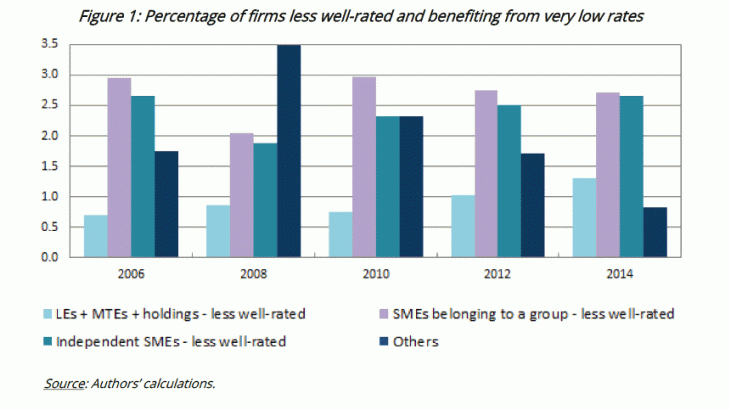The financial crisis in 2009 marked a break in the upward trend in bank lending rates since 2005. Median rates fell by around 5 percentage points (pp) in less than a year on short-term loans and by around 3 pp over two years for long-term loans (see Figure 2). In 2010-11, they rose again slightly as a result of the sovereign debt crisis in some euro area countries. Once tensions subsided, the downward trend in rates resumed, especially for loans with duration of more than one year. Overall, from end-2008 to end-2014, median rates fell by around 4 pp for both short- and long-term loans.
Around 10% of firms benefiting from very low rates
The Banque de France rating system for firms is based on an expert assessment made by financial analysts. It takes into account both financial and qualitative criteria; it covers about 280,000 firms with a turnover of more than 750K euros. It includes 11 ratings ranging from an excellent situation to a compromised situation, in addition to a rating given in the absence of adverse information and recent documentation, and another rating associated with legal insolvency.
A firm is assumed to to have been granted particularly advantageous borrowing conditions (very low rates) if the rate on its loan is lower than the first decile of the rates for the healthiest firms, i.e. the highest rate offered to 10% of the firms benefiting from the lowest rates and the best rating of the Banque de France.
Over the whole sample, around 10 % of firms on average benefit from low-interest loans. This share slightly increased in 2010, before a net decline in 2014. Besides, as a percentage of the volume of new lending, this proportion is around 20%. This reflects the fact that the rates correspond to fairly high loan volumes. This latter proportion significantly increased following the crisis before converging back to its back to its long-run level in the recent period.
Firms benefiting from loans with very low interest may be financially sound. Thereby, it is interesting to look at the share of these loans extended to firms less well-rated by Banque de France (5+ and worst, the 5+ threshold being determined by taking into account the minimum quality requirement for signatures of receivables defined by the Eurosystem) also considering their size. A rise in the share of low-rated companies receiving very-low-interest loans would be strong evidence of zombie lending.
Relatively stable and weak shares of firms “less well-rated” benefiting from very low rates
Figure 3a shows that, for each size category, the share of firms with the lowest rating and with very low interest rates is more or less stable over the period: between 2% and 3% of small and medium-sized enterprises (SMEs) and around 1% of all large enterprises (LEs), mid-tier enterprises (MTEs) and holdings. The share of loans with very low interest rates in new loans is more volatile and significant (see Figure 3b), which reflects the sensitivity of the indicator to large-value loans.
